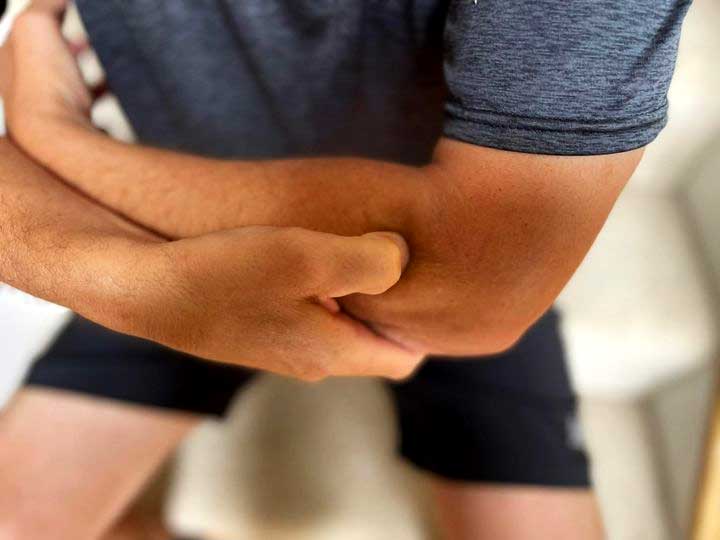What is Pickleball Elbow Pain
Adults who are starting to play Pickleball for the first time may commonly experience pain on the inside or the outside of their elbow after practice, a lesson or a competitive match. This may be referred to as Pickleball Elbow.
Pickleball elbow is a term adapted from the term tennis elbow which is actually called lateral epicondylitis. Lateral epicondylitis is a diagnosis of inflammation at the muscle/tendon attachments on the outside of the elbow.
A related term for inflammation on the inside of the elbow is medial epicondylitis. Medial epicondylitis is more commonly referred to as golfer’s elbow.
Table of Contents:
- Why does my elbow hurt after playing pickleball?
- Pickleball elbow pain home treatment options.
- Do elbow braces and straps work?
- Self massage for pickleball elbow pain.
- What is the difference between tendinitis, tendinosis, and tendinopathy?
Why Does My Elbow Hurt After Pickleball?
Both lateral and medial epicondylitis is often referred to as an “Overuse Injury.”
I have been a physical therapy and strength coach for more than 20 years. I have seen lots of reasons for these conditions to develop. In some cases it actually is an acute bout of overuse. In other cases there might be some hidden problems going on at the neck or shoulder causing compensations at the lateral elbow.
In other cases there are some swing technique deficiencies. Lack of strength by be a contributing factor. Poor tissue healing or slow recovery could also result in this condition.
Ultimately, if you have been dealing with pickleball elbow pain and it isn’t improving with a couple days of rest, you should consider scheduling a consultation with a licensed physical therapist who specializes in treating Pickleball players or racket sports athletes in general.
As more people start playing Pickleball, the injuries specific to the sport are becoming more consistent. A common complaint found among Pickleball players is Pickleball Elbow (similar to Tennis Elbow). Pickleball elbow is referred to as Lateral Epicondylitis in the medical field. It is caused by overuse of the forearm muscles due to bad mechanics, leading to pain, micro-tearing, inflammation, and weakness. This condition can be debilitating, as it can affect a person’s ability to perform daily activities as well as their recreational activities.
What is the difference between Tendinitis, Tendinosis, and Tendonopathy?
Tendinitis
Tendinitis is the inflammation of the tendon and results from micro-tears that happen when the musculotendinous unit is acutely overloaded with a tensile force that is too heavy and/or too sudden. [1]
Tendinosis
Tendinosis is a degeneration of the tendon’s collagen in response to chronic overuse; when overuse is continued without giving the tendon time to heal and rest, such as with repetitive strain injury, tendinosis results.
Tendinopathy
Tendinopathy is an all encompassing term that includes both tendinitis and tendinosis.
Do Elbow Braces and Straps Actually Work?
Elbow braces, straps, or sleeves work in some ways for some people, but not in the way we expect.
This study compared maximum and pain-free grip strength which was assessed using a digital hand grip dynamometer immediately after the application of each orthosis. The 4 testing conditions included:
- a placebo orthosis as a control condition,
- an elbow strap orthosis,
- an elbow sleeve orthosis,
- and a wrist splint.
Data were analyzed using a 1-way analysis of variance for each outcome measure. [2]
Findings for the Study
1. Pain-free grip-strength was greater when using the elbow strap or the elbow sleeve orthosis compared to when using the placebo control orthosis or the wrist splint (P<.02).
2. There was no difference between the elbow sleeve and strap orthoses (P>.05).
3. There was also no difference between the wrist splint and placebo orthosis (P>.05).
4. Maximum grip strength was less when using the wrist splint compared to when tested with the elbow sleeve or the elbow strap (P< or =.003).
5. Use of the elbow strap, elbow sleeve, or wrist splint did not change maximum grip strength compared to the control placebo orthosis condition (P>.05).
6. There was also no difference in maximum grip strength between the elbow strap and the elbow sleeve conditions (P>.05).
How to Treat Pickleball Elbow Pain At Home
R.I.C.E used to be a common acronym in acute injury rehabilitation.
Rest – if you develop elbow pain after playing pickleball, rest the elbow for 24 to 48 hours.
Ice – you could try icing the painful elbow. Ice if often applied for 10 to 20-minutes in the form of a gel-pack, a plastic bag filled with crushed ice, or an ice-bucket soak.
Compression – elbow compression sleeves or wraps may help reduce acute swelling often associated with inflammation.
Elevate – it can be difficult, but there are some wedge shaped pillows or other ways to elevate the arm to allow gravity assisted drainage of lymphatic fluid and other waste products.
M.I.C.E. is a more modern methology.
Movement – “The Whartons advocated that once fracture or catastrophic injury is excluded: movement is best, not rest, to treat an injury. They encourage immediate but gentle restoration of active range of motion with gradual introduction of functional activities. They note that inactivity shuts the muscle down. Blood flow is restricted and tissue atrophy follows. In contrast, activity improves blood flow, which brings oxygen and removes metabolic waste.” Link
Inflammation – We often associate inflammation with pain, swelling, and other netagive symptoms. The reality is that inflammation is necessary for tissue healing. It is our body’s immune system working to remove debrit and restore tissue. By allowing inflammation to do its job, the injured area might heal more quickly and become more resilient to future injury.
Compression – Intermittant compression may or may not be beneficial. The evidence is inconclusive, but there appears to be no evidence to suggest risk associated with elevation. In my physical therapy clinic I may recommen episodes of 10-minutes of elevation just to keep the arm in a position that allows gravity to assist lymphatic drainage three or four times a day.
Exercise – Along with movement, early exercises to perform during the recovery process are often simple isometric muscle contractions in a pain free elbow position or passive range of motion exercises to keep the collegen fibers pliable.
Self Massage for Pickleball Elbow Pain
Self massage is a great way to increase fluid exchange and facilitate healing. Cross fiber massage and accupressure are two treatment techniques that may be utilized on sore muscles on the lateral elbow and forearm.
In the image below you can see a sustained pressure applied using my thumb to the most sensitive area of the lateral forearm. I usually hold this pressure for 20-seconds before releasing the pressure for 40-seconds. I will repeat this 3 times per episode and 3 episodes per day.

Reference:
1. Bass E. Tendinopathy: why the difference between tendinitis and tendinosis matters. Int J Ther Massage Bodywork. 2012;5(1):14-17. doi:10.3822/ijtmb.v5i1.153
2. Jafarian FS, Demneh ES, Tyson SF. The immediate effect of orthotic management on grip strength of patients with lateral epicondylosis. J Orthop Sports Phys Ther. 2009 Jun;39(6):484-9. doi: 10.2519/jospt.2009.2988. PMID: 19487823.

